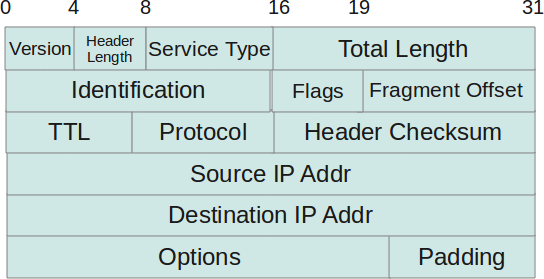How to Calculate IP Header Checksum (With an Example)
来源:互联网 发布:宁夏隆盛软件下载 编辑:程序博客网 时间:2024/05/29 03:58
关于IP header的checksum的计算方式, 即时是在TCP/IP详解里面也是讲的不够清楚, 网上的这篇文章就很清晰了.
http://www.thegeekstuff.com/2012/05/ip-header-checksum/
If you have ever tried to understand the TCP/IP protocols then you would have definitely stumbled upon the checksum field that is the part of protocol headers like TCP, IP etc.
Have you ever given a thought about things like what exactly is checksum, why is it used and how it is calculated. Well, in this article we will have a brief discussion on the concept of checksum and then we will go into details of how checksum is calculated.
What is Checksum?
A check sum is basically a value that is computed from data packet to check its integrity. Through integrity, we mean a check on whether the data received is error free or not. This is because while traveling on network a data packet can become corrupt and there has to be a way at the receiving end to know that data is corrupted or not. This is the reason the checksum field is added to the header. At the source side, the checksum is calculated and set in header as a field. At the destination side, the checksum is again calculated and crosschecked with the existing checksum value in header to see if the data packet is OK or not.
IP header checksum
IP header checksum is calculated over IP header only as the data that generally follows the IP header (like ICMP, TCP etc) have their own checksums. Now, to calculate the IP header algorithm one must know the basic header structure of IP protocol. So here is a basic format of how IP header looks like :

NOTE: To have a good understanding of the IP header fields, refer to:IP Protocol Header Fundamentals
So, as far as the algorithm goes, IP header checksum is : 16 bit one’s complement of the one’s complement sum of all 16 bit words in the header
This means that if we divide the IP header is 16 bit words and sum each of them up and then finally do a one’s compliment of the sum then the value generated out of this operation would be the checksum.
Now, the above is done at the source side which is sending the data packet. At the destination side which receives the data packet replaces the checksum value in the header with all zeros and then calculates the checksum based on the same algorithm as mentioned above. After a checksum value is obtained then this value is compared with the value that came in the header. This comparison decides whether the IP header is fine or corrupted.
IP Header Checksum Example
Since now we have enough theoretical knowledge on IP header checksum, lets take an IP header and actually try this algorithm out.
Here is a IP header from an IP packet received at destination :
4500 003c 1c46 4000 4006 b1e6 ac10 0a63 ac10 0a0c
Lets first map these values with the header
- ’45′ corresponds to the first two fields in the header ie ’4′ corresponds to the IP version and ’5′ corresponds to the header length. Since header length is described in 4 byte words so actual header length comes out to be 5×4=20 bytes.
- ’00′ corresponds to TOS or the type of service. This value of TOS indicated normal operation.
- ’003c’ corresponds to total length field of IP header. So in this case the total length of IP packet is 60.
- ’1c46′ corresponds to the identification field.
- ’4000′ can be divided into two bytes. These two bytes (divided into 3 bits and 13 bits respectively) correspond to the flags and fragment offset of IP header fields.
- ’4006′ can be divided into ’40′ and ’06′. The first byte ’40′ corresponds to the TTL field and the byte ’06′ corresponds to the protocol field of the IP header. ’06′ indicates that the protocol is TCP.
- ‘be16′ corresponds to the checksum which is set at the source end (which sent the packet). Please note that as already discussed this field will be set to zero while computing the checksum at destination end.
- The next set of bytes ‘ac10′ and ’0a0c’ correspond to the source IP address and the destination IP address in the IP header.
So now we have a basic idea as to what these fields map to in IP header. Lets convert all these values in binary :
4500 -> 0100010100000000003c -> 00000000001111001c46 -> 00011100010001104000 -> 01000000000000004006 -> 01000000000001100000 -> 0000000000000000 // Note that the checksum is set to zero since we are computing checksum at destination endac10 -> 10101100000100000a63 -> 0000101001100011ac10 -> 10101100000100000a0c -> 0000101000001100
Now lets add these binary values one by one :
4500 -> 0100010100000000003c -> 0000000000111100453C -> 0100010100111100 /// First result453C -> 0100010100111100 // First result plus next 16-bit word.1c46 -> 00011100010001106182 -> 0110000110000010 // Second result.6182 -> 0110000110000010 // Second result plus next 16-bit word.4000 -> 0100000000000000A182 -> 1010000110000010 // Third result.A182 -> 1010000110000010 // Third result plus next 16-bit word.4006 -> 0100000000000110E188 -> 1110000110001000 // Fourth result.E188 -> 1110000110001000 // Fourth result plus next 16-bit word.AC10 -> 101011000001000018D98 -> 11000110110011000 // One odd bit (carry), add that odd bit to the result as we need to keep the checksum in 16 bits.18D98 -> 110001101100110008D99 -> 1000110110011001 // Fifth result8D99 -> 1000110110011001 // Fifth result plus next 16-bit word.0A63 -> 000010100110001197FC -> 1001011111111100 // Sixth result97FC -> 1001011111111100 // Sixth result plus next 16-bit word.AC10 -> 10101100000100001440C -> 10100010000001100 // Again a carry, so we add it (as done before)1440C -> 10100010000001100440D -> 0100010000001101 // This is seventh result440D -> 0100010000001101 //Seventh result plus next 16-bit word0A0C -> 00001010000011004E19 -> 0100111000011001 // Final result.
So now 0100111000011001 is our final result of summing up all the 16 bit words in the header. As a last step we just need to do a one’s compliment of it to obtain the checksum.
4E19 -> 0100111000011001B1E6 ->1011000111100110 // CHECKSUM
Now if you compare this checksum with the one obtained in the packet you will find that both are exactly same and hence the IP header’s integrity was not lost.
So this is the way we calculate IP header checksum to check the integrity of IP header.
- How to Calculate IP Header Checksum (With an Example)
- How to Calculate IP/TCP/UDP Checksum
- How to Calculate IP/TCP/UDP Checksum–Part 3 Usage Example and Validation
- How to Prevent SQL Injection Attack (Explained with an Example)
- How to setup FlumeNG with example configuration
- IP协议 Header Checksum算法
- how to calculate ANOVA
- How to Make an HTTP Connection Using TCP/IP with RSocket
- How to Make an HTTP Connection Using TCP/IP with RSocket
- How to Make an HTTP Connection Using TCP/IP with RSocket
- An example of how to do a simulation by LAMMPS
- How to convert ArrayList to Set in Java with Example
- An UDF to calculate weekday
- IP Header Checksum计算c实现
- IP Header Checksum计算c实现
- IP Header Checksum计算c实现
- How to use Comparator and Comparable in Java? With example
- How to deal with an SVM with categorical attributes?
- nyoj 12 喷水装置(二) 贪心 区间覆盖
- Activity
- js实现简单的图片切换
- 微软网站被黑了吗?
- Prime Ring Problem
- How to Calculate IP Header Checksum (With an Example)
- Andorid存储目录知识总结及文件操作方法封装
- 第八周 项目三 分数类中的运算符重载(1)
- python 各种模块学习
- Jquery-zTree的基本用法
- Nginx系列(二.nginx编译参数详解)
- send函数理解
- hadoop版的Hello,World
- grunt学习


